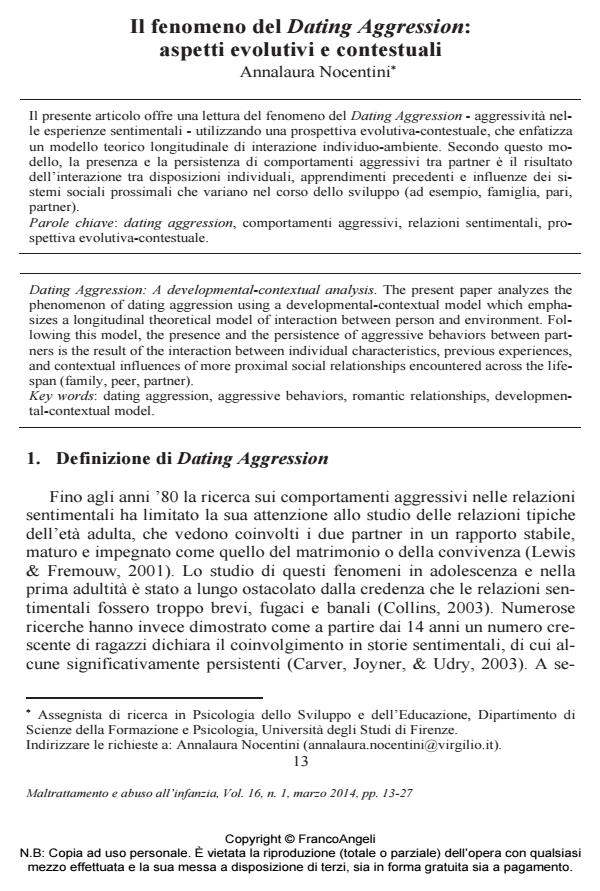Il fenomeno del Dating Aggression: aspetti evolutivi e contestuali
Titolo Rivista MALTRATTAMENTO E ABUSO ALL’INFANZIA
Autori/Curatori Annalaura Nocentini
Anno di pubblicazione 2014 Fascicolo 2014/3
Lingua Italiano Numero pagine 15 P. 13-27 Dimensione file 100 KB
DOI 10.3280/MAL2014-003002
Il DOI è il codice a barre della proprietà intellettuale: per saperne di più
clicca qui
Qui sotto puoi vedere in anteprima la prima pagina di questo articolo.
Se questo articolo ti interessa, lo puoi acquistare (e scaricare in formato pdf) seguendo le facili indicazioni per acquistare il download credit. Acquista Download Credits per scaricare questo Articolo in formato PDF

FrancoAngeli è membro della Publishers International Linking Association, Inc (PILA)associazione indipendente e non profit per facilitare (attraverso i servizi tecnologici implementati da CrossRef.org) l’accesso degli studiosi ai contenuti digitali nelle pubblicazioni professionali e scientifiche
Il presente articolo offre una lettura del fenomeno del Dating Aggression - aggressività nelle esperienze sentimentali - utilizzando una prospettiva evolutiva-contestuale, che enfatizza un modello teorico longitudinale di interazione individuo-ambiente. Secondo questo modello, la presenza e la persistenza di comportamenti aggressivi tra partner è il risultato dell’interazione tra disposizioni individuali, apprendimenti precedenti e influenze dei sistemi sociali prossimali che variano nel corso dello sviluppo (ad esempio, famiglia, pari, partner).
Parole chiave:Dating aggression, comportamenti aggressivi, relazioni sentimentali, prospettiva evolutiva-contestuale.
- Teen Dating Violence: lo psicologo scolastico alla frontiera tra prevenzione e interventi di presa in carico territoriale ed interistituzionale Roberta Di Pasquale, Andrea Rivolta, Lina Vita Losacco, in PSICOLOGIA DELLA SALUTE 3/2025 pp.29
DOI: 10.3280/PDS2025-003004 - Il minore reo sessuale tra pena e trattamento: una ricerca nell'area milanese Paolo Giulini, Federica de Gregorio, in MALTRATTAMENTO E ABUSO ALL'INFANZIA 3/2017 pp.53
DOI: 10.3280/MAL2016-003004 - Stile genitoriale autoritario, giustificazione della violenza e messa in atto di comportamenti di Dating Aggression Maria Giulia Olivari, Gaia Cuccì, Emanuela Confalonieri, in MALTRATTAMENTO E ABUSO ALL'INFANZIA 3/2017 pp.13
DOI: 10.3280/MAL2017-003002 - Teen dating violence e fattori post-migratori: una disamina della letteratura psicosociale Cristina Giuliani, in MALTRATTAMENTO E ABUSO ALL'INFANZIA 3/2017 pp.31
DOI: 10.3280/MAL2017-003003 - La Dating violence negli adolescenti e nei giovani adulti: fattori di rischio e di protezione nella ricerca in ambito nazionale e internazionale Emanuela Confalonieri, in MALTRATTAMENTO E ABUSO ALL'INFANZIA 3/2017 pp.7
DOI: 10.3280/MAL2017-003001
Annalaura Nocentini, Il fenomeno del Dating Aggression: aspetti evolutivi e contestuali in "MALTRATTAMENTO E ABUSO ALL’INFANZIA" 3/2014, pp 13-27, DOI: 10.3280/MAL2014-003002